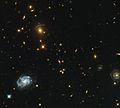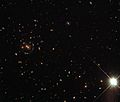Sloan Digital Sky Survey facts for kids
The Sloan Digital Sky Survey or SDSS is a big project that maps the universe. It uses a powerful telescope in Apache Point Observatory in New Mexico, United States. This telescope takes pictures of millions of stars and galaxies. It also measures how far away they are. The project got its name from the Alfred P. Sloan Foundation, which helped pay for it.
Contents
Mapping the Universe
The SDSS is like making a giant map of the sky. It looks at a huge part of the universe. This project helps scientists understand how the universe grew. It also helps them learn about galaxies, stars, and mysterious objects called quasars.
How the SDSS Works
The SDSS uses a special telescope. This telescope is 2.5 meters (about 8 feet) wide. It can see a very wide area of the sky at once.
Taking Pictures of the Sky
The telescope takes pictures using different colors of light. This is called "multi-spectral imaging." It helps scientists see different features of stars and galaxies. Imagine taking pictures with different color filters.
Measuring Distances with Redshift
The SDSS also does a "spectroscopic redshift survey." This sounds complicated, but it's really cool!
- Light from faraway galaxies stretches as the universe expands.
- This stretching makes the light look redder, like a siren sounding lower as it moves away.
- Scientists measure how "red" the light is. This tells them how far away a galaxy is.
- It also tells them how fast the galaxy is moving away from us.
What the SDSS Has Found
The SDSS has made many amazing discoveries. It has created the most detailed 3D maps of the universe ever.
Discovering New Galaxies and Quasars
Scientists have found millions of new galaxies. They have also found many quasars. Quasars are super bright centers of young galaxies. They are powered by giant black holes.
Understanding Dark Energy
The SDSS helps us learn about "dark energy." Dark energy is a mysterious force. It makes the universe expand faster and faster. By mapping galaxies, scientists can see how this expansion has changed over time.
Looking Back in Time
When we look at very distant objects, we are seeing light that left them a long time ago. So, the SDSS lets us look back in time. It shows us what the universe looked like billions of years ago. This helps us understand its history.
Images for kids
-
SDSS map shown as a rainbow of colors, located within the observable Universe (the outer sphere, showing fluctuations in the Cosmic Microwave Background). As we look out in distance, we look back in time. So, the location of these signals reveals the expansion rate of the Universe at different times in cosmic history. (2020)
See also
 In Spanish: Sloan Digital Sky Survey para niños
In Spanish: Sloan Digital Sky Survey para niños





